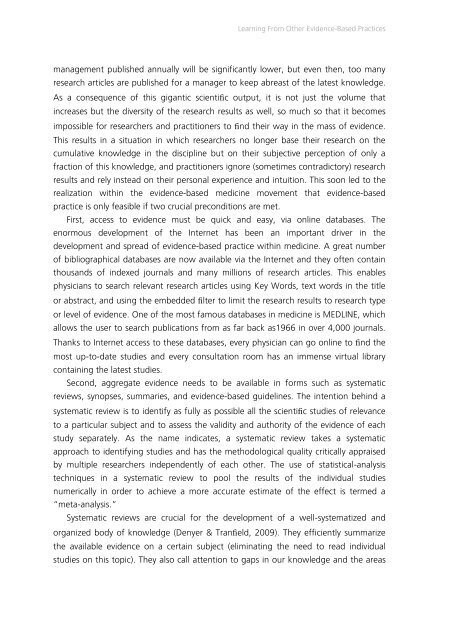In Search of Evidence
jqluvth
jqluvth
You also want an ePaper? Increase the reach of your titles
YUMPU automatically turns print PDFs into web optimized ePapers that Google loves.
Learning From Other <strong>Evidence</strong>-Based Practices<br />
management published annually will be significantly lower, but even then, too many<br />
research articles are published for a manager to keep abreast <strong>of</strong> the latest knowledge.<br />
As a consequence <strong>of</strong> this gigantic scientific output, it is not just the volume that<br />
increases but the diversity <strong>of</strong> the research results as well, so much so that it becomes<br />
impossible for researchers and practitioners to find their way in the mass <strong>of</strong> evidence.<br />
This results in a situation in which researchers no longer base their research on the<br />
cumulative knowledge in the discipline but on their subjective perception <strong>of</strong> only a<br />
fraction <strong>of</strong> this knowledge, and practitioners ignore (sometimes contradictory) research<br />
results and rely instead on their personal experience and intuition. This soon led to the<br />
realization within the evidence-based medicine movement that evidence-based<br />
practice is only feasible if two crucial preconditions are met.<br />
First, access to evidence must be quick and easy, via online databases. The<br />
enormous development <strong>of</strong> the <strong>In</strong>ternet has been an important driver in the<br />
development and spread <strong>of</strong> evidence-based practice within medicine. A great number<br />
<strong>of</strong> bibliographical databases are now available via the <strong>In</strong>ternet and they <strong>of</strong>ten contain<br />
thousands <strong>of</strong> indexed journals and many millions <strong>of</strong> research articles. This enables<br />
physicians to search relevant research articles using Key Words, text words in the title<br />
or abstract, and using the embedded filter to limit the research results to research type<br />
or level <strong>of</strong> evidence. One <strong>of</strong> the most famous databases in medicine is MEDLINE, which<br />
allows the user to search publications from as far back as1966 in over 4,000 journals.<br />
Thanks to <strong>In</strong>ternet access to these databases, every physician can go online to find the<br />
most up-to-date studies and every consultation room has an immense virtual library<br />
containing the latest studies.<br />
Second, aggregate evidence needs to be available in forms such as systematic<br />
reviews, synopses, summaries, and evidence-based guidelines. The intention behind a<br />
systematic review is to identify as fully as possible all the scientific studies <strong>of</strong> relevance<br />
to a particular subject and to assess the validity and authority <strong>of</strong> the evidence <strong>of</strong> each<br />
study separately. As the name indicates, a systematic review takes a systematic<br />
approach to identifying studies and has the methodological quality critically appraised<br />
by multiple researchers independently <strong>of</strong> each other. The use <strong>of</strong> statistical-analysis<br />
techniques in a systematic review to pool the results <strong>of</strong> the individual studies<br />
numerically in order to achieve a more accurate estimate <strong>of</strong> the effect is termed a<br />
“meta-analysis.”<br />
Systematic reviews are crucial for the development <strong>of</strong> a well-systematized and<br />
organized body <strong>of</strong> knowledge (Denyer & Tranfield, 2009). They efficiently summarize<br />
the available evidence on a certain subject (eliminating the need to read individual<br />
studies on this topic). They also call attention to gaps in our knowledge and the areas


